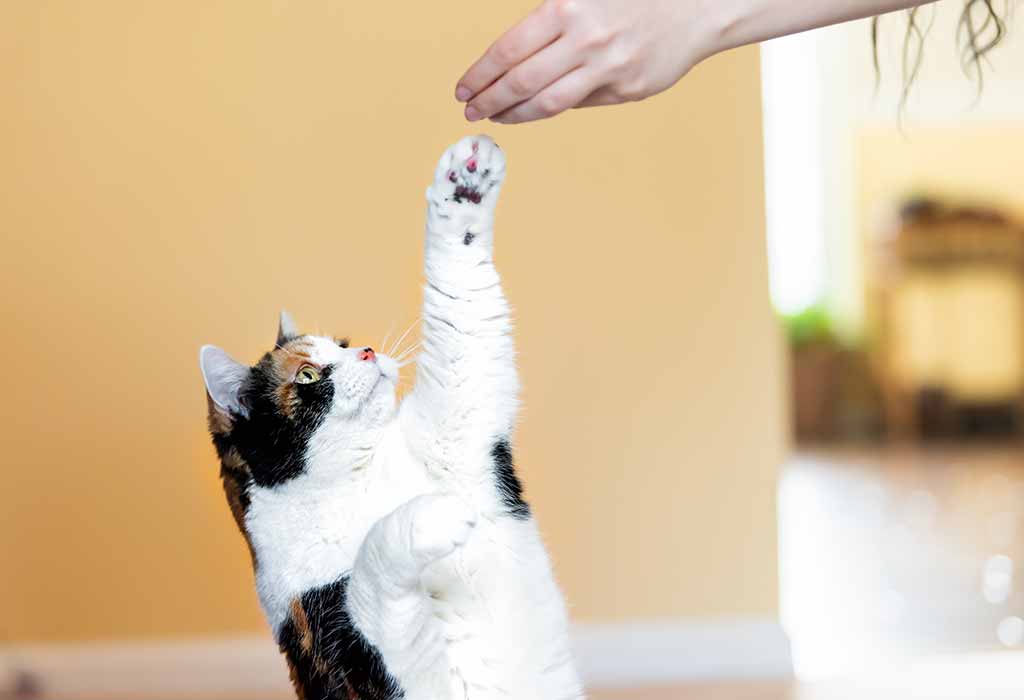Can We Train Our Kitty? 🐈

It is almost certain that after having brought home a cat as a friend and companion, you must have thought about communicating with her/him. Well, why wouldn’t you? Who wouldn’t want to be talked to and responded to?
Besides, it is very important to train someone in the ‘desirable’ and ‘likable’ way so that there are no accidents and unpleasant episodes. You want to train your pet so that there is harmony between the two of you. In other words, you want to make her social and also teach her to remain content and calm around humans.
So, how do you start?
The starting point is setting your expectations. If you think you can train your cat the same way as a dog can be then we suggest you take a break. Different animals have different ways of behaving. Therefore, each animal requires a different skill and method of training. Cats might appear aloof or uninterested in following your commands. That doesn’t mean you can’t influence their behavior, though. If you are patient and consistent, your new kitten or older cat can be trained in no time.
What Do You Want to Train?
You will begin with very basic first steps that both reward likable behavior and discourage the bad. Also, it is important to determine what do you want your cat to learn. Some of the areas could be: how to train your cat to use a litter box, how to keep her calm on trips to the veterinarian’s office, and the like. How can you teach her to stop scratching your rugs or furniture; Coming to you when you call or gesture; Staying calm and still for grooming; Interacting with you, other people, or other animals.
Keep Each ‘Session’ Short and Natural
First and foremost, your cat’s attention span is shorter than yours; you can’t expect her to stay interested every time you’re ready to be the trainer. Let the lesson dictate how long she’s willing to be in your company.
Start Small
To be successful, though, it’s a better idea to practice one lesson at a time. Once your cat has mastered whatever you’re working on, you can move on to the next training exercise.
Don’t Limit Her to One Area
Once your cat has learned a command, practice it in different areas of your home. If you’re introducing a kitten to other preexisting pets, and only bring them together in the living room, she may believe the other animal only exists in that space. This isn’t a problem if your other animal is a fish, but if your kitten is meeting a dog, she needs to understand she’ll encounter him in other areas as well.
Involve Other People
If the only two residents are you and your cat, you don’t have to worry too much about involving others in the training process. Yet you still want your cat to learn to be social, not territorial. Shortly after bringing your cat home, invite friends or family members over to socialize with your new pet. Just remind them not to be too forward with their introduction. Just as you practice training in small spurts, you should allow your pet the same leeway.
Use A Reward System
Rewards to reinforce good behavior are great motivators, especially during training. There are two types of rewards for your furry new friend to test out. First, know she will enjoy any positive praise you have to share. Speak in a kind, upbeat voice and remind her how proud you are. Say, “What a good girl” and “good job!” while petting or scratching her fur so she knows these gestures mean well.
Cats also respond well to treats. Reward her with small kibbles of treats when she correctly masters the commands you’re working on. One way to do this is to use a “clicker” system. When your cat performs the right behavior or action, sound a tool that clicks, and then give her a treat that signals a job well done. Hearing this noise each time she does a job well done will reinforce the good behavior you’re training her to learn.
If It Isn’t Working
Training doesn’t happen overnight, and sometimes your cat will make a mistake. Can you train a cat to bounce back from it? Of course, but before you begin, you should come up with a plan for how to correct or guide her when she seems reluctant to catch on. Punishment doesn’t work well when you’re trying to train a kitten because your cat simply won’t understand why she’s in trouble. It could make her worse and feel more reclusive.
You’d never slap, shake, or physically correct your kitten during training, but don’t forget to keep your voice just as calm. If your cat feels threatened by you, not only will training begin to fail, but she’ll only learn to be afraid of you.



 Dry Cat Food
Dry Cat Food  Dry Kitten Food
Dry Kitten Food  Premium Adult Food
Premium Adult Food  Premium Kitten Food
Premium Kitten Food  Wet Cat Food
Wet Cat Food 
 Creamy And Soft Treats
Creamy And Soft Treats  Crunchy and Jerky Treats
Crunchy and Jerky Treats  Nuggets
Nuggets 
 Lint Rollers And More
Lint Rollers And More  Litter Scoops
Litter Scoops  Litter Trays And Houses
Litter Trays And Houses  Cat Litter
Cat Litter  Odor & Stain Removers
Odor & Stain Removers 
 Bowls And Feeders
Bowls And Feeders  Brushes, Nail Clippers And Trimmers
Brushes, Nail Clippers And Trimmers  Carry and Travel Bag
Carry and Travel Bag  Cat Beds & Mats
Cat Beds & Mats  Cat Clothing
Cat Clothing  Cat Toys & Puzzles
Cat Toys & Puzzles  Collars Leashes and Harnesses
Collars Leashes and Harnesses  Ear And Paw Care
Ear And Paw Care  Oral Care
Oral Care  Shampoo And Conditioners
Shampoo And Conditioners  Vitamins And Supplements
Vitamins And Supplements 